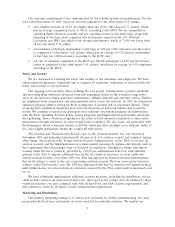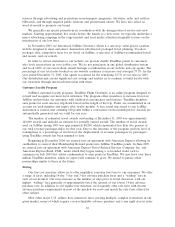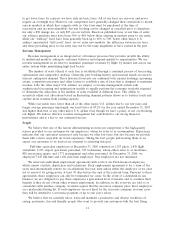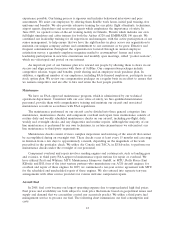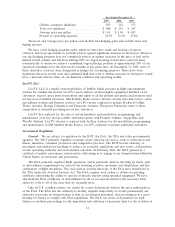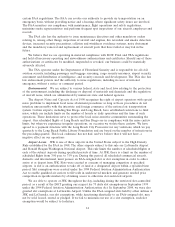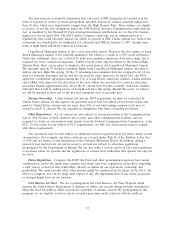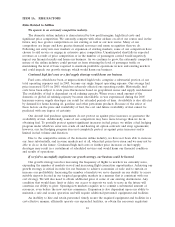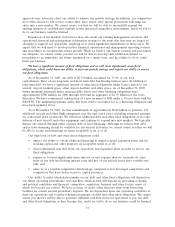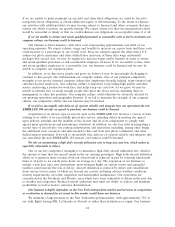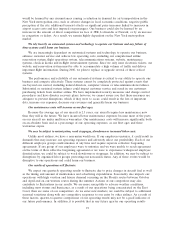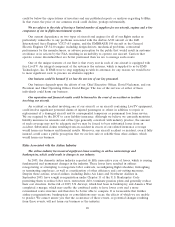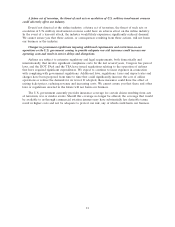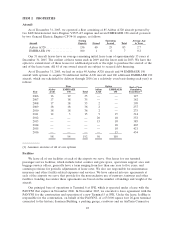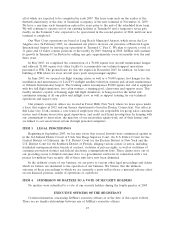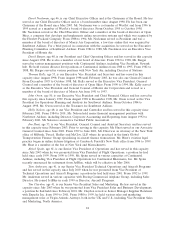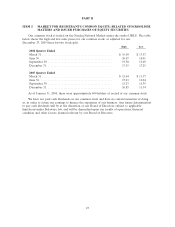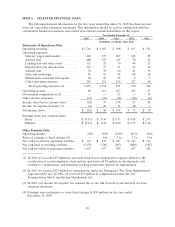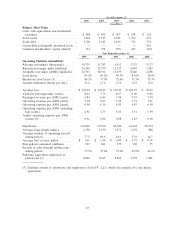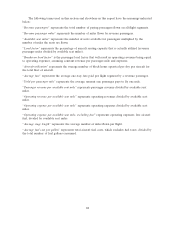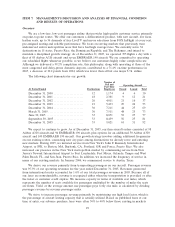JetBlue Airlines 2005 Annual Report Download - page 27
Download and view the complete annual report
Please find page 27 of the 2005 JetBlue Airlines annual report below. You can navigate through the pages in the report by either clicking on the pages listed below, or by using the keyword search tool below to find specific information within the annual report.would be harmed by any circumstances causing a reduction in demand for air transportation in the
New York metropolitan area, such as adverse changes in local economic conditions, negative public
perception of the city, additional terrorist attacks or significant price increases linked to increases in
airport access costs and fees imposed on passengers. Our business could also be harmed by an
increase in the amount of direct competition we face at JFK, LaGuardia or Newark, or by an increase
in congestion or delays. As a result, we remain highly dependent on the New York metropolitan
market.
We rely heavily on automated systems and technology to operate our business and any failure of
these systems could harm our business.
We are increasingly dependent on automated systems and technology to operate our business,
enhance customer service and achieve low operating costs, including our computerized airline
reservation system, flight operations system, telecommunications systems, website, maintenance
systems, check-in kiosks and in-flight entertainment systems. Since we only issue electronic tickets, our
website and reservation system must be able to accommodate a high volume of traffic and deliver
important flight information. During 2006, we plan to replace or upgrade several of these critical
systems.
The performance and reliability of our automated systems is critical to our ability to operate our
business and compete effectively. These systems cannot be completely protected against events that
are beyond our control, including natural disasters, computer viruses or telecommunications failures.
Substantial or sustained system failures could impact customer service and result in our customers
purchasing tickets from another airline. We have implemented security measures and change control
procedures and have disaster recovery plans; however, we cannot assure you that these measures are
adequate to prevent disruptions, which, if they were to occur, could result in the loss of important
data, increase our expenses, decrease our revenues and generally harm our business.
Our maintenance costs will increase as our fleet ages.
Because the average age of our aircraft is 2.5 years, our aircraft require less maintenance now
than they will in the future. We have incurred lower maintenance expenses because most of the parts
on our aircraft are under multi-year warranties. Our maintenance costs will increase significantly, both
on an absolute basis and as a percentage of our operating expenses, as our fleet ages and these
warranties expire.
We may be subject to unionization, work stoppages, slowdowns or increased labor costs.
Unlike most airlines, we have a non-union workforce. If our employees unionize, it could result in
demands that may increase our operating expenses and adversely affect our profitability. Each of our
different employee groups could unionize at any time and require separate collective bargaining
agreements. If any group of our employees were to unionize and we were unable to reach agreement
on the terms of their collective bargaining agreement or we were to experience widespread employee
dissatisfaction, we could be subject to work slowdowns or stoppages. In addition, we may be subject to
disruptions by organized labor groups protesting our non-union status. Any of these events would be
disruptive to our operations and could harm our business.
Our results of operations will fluctuate.
We expect our quarterly operating results to fluctuate due to price changes in aircraft fuel as well
as the timing and amount of maintenance and advertising expenditures. Seasonality also impacts our
operations, with high vacation and leisure demand occurring on the Florida routes between October
and April and on our western routes during the summer. Actions of our competitors may also
contribute to fluctuations in our results. We are more susceptible to adverse weather conditions,
including snow storms and hurricanes, as a result of our operations being concentrated on the East
Coast, than are some of our competitors. As we enter new markets, we could be subject to additional
seasonal variations along with any competitive responses to our entry by other airlines. As a result of
these factors, quarter-to-quarter comparisons of our operating results may not be a good indicator of
our future performance. In addition, it is possible that in any future quarter our operating results
19


